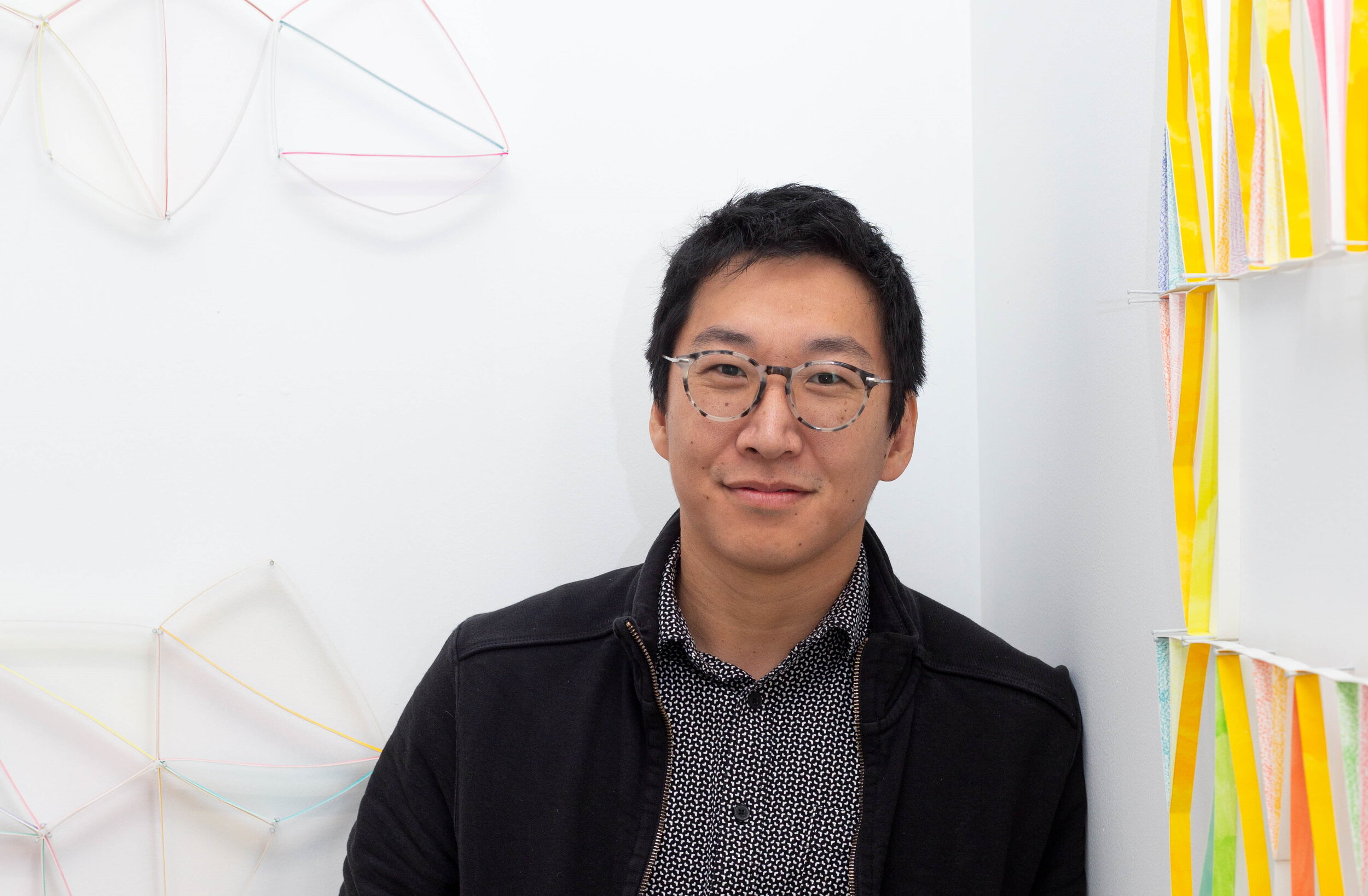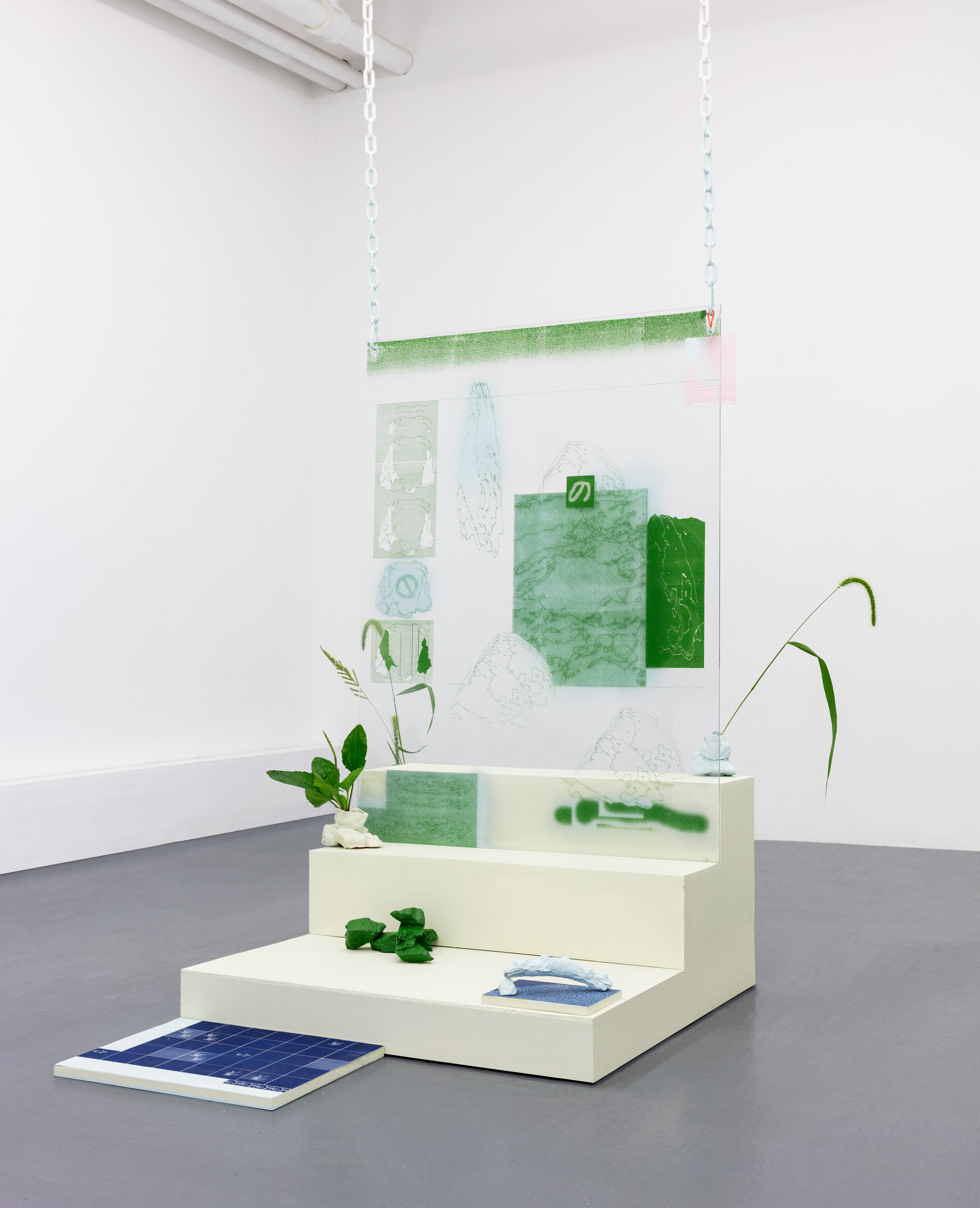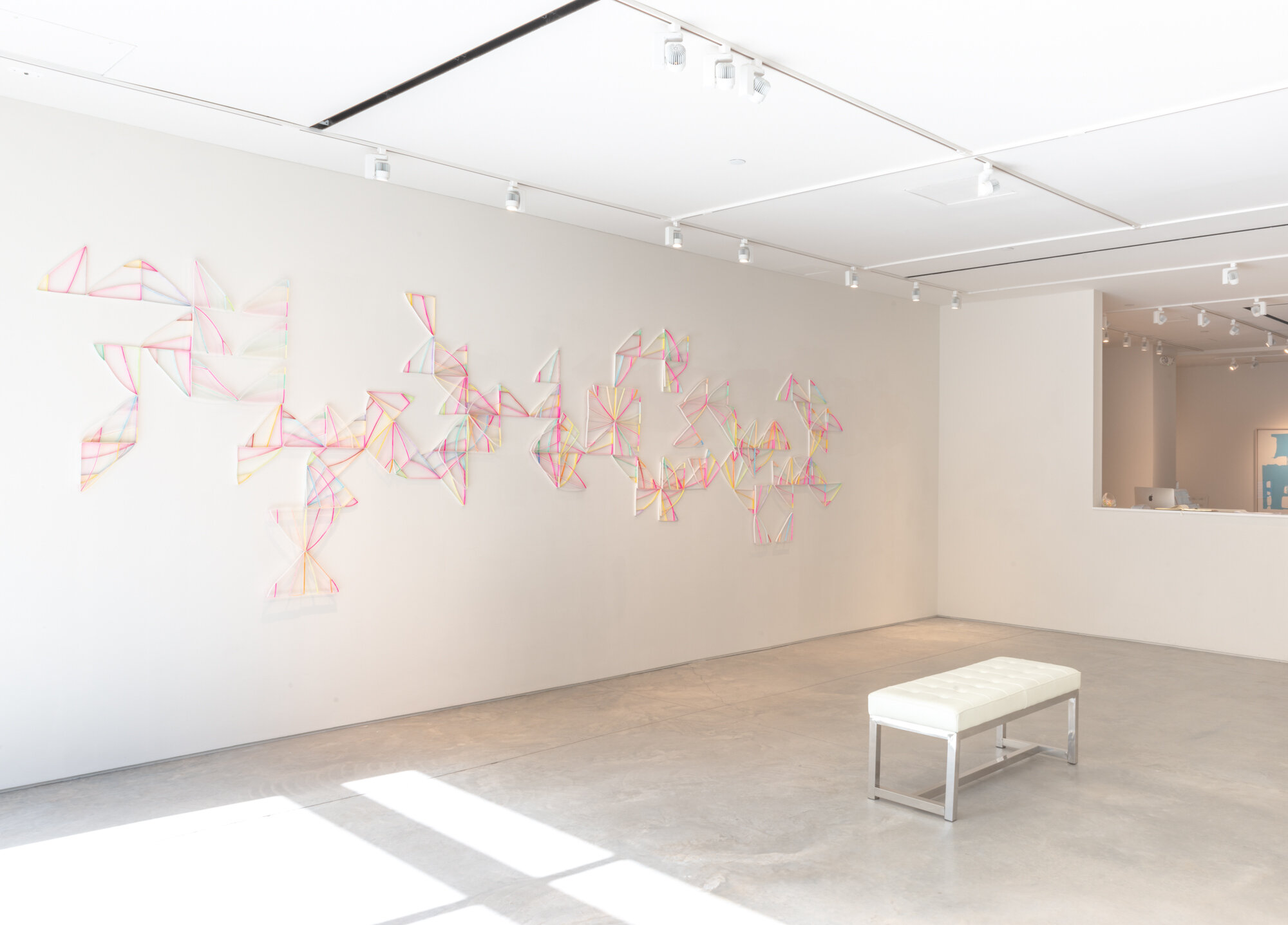Portrait of Alex Paik
Alex Paik
Alex Paik is an artist living and working in Brooklyn. His modular, paper-based wall installations explore perception, interdependence, and improvisation within structure while engaging with the complexities of social dynamics. He has exhibited in the U.S. and internationally, with notable solo projects at Praxis New York, Art on Paper 2016, and Gallery Joe. His work has also been featured in group exhibitions at BravinLee Projects, Lesley Heller Workspace, and MONO Practice, among others. Paik is Founder and Director of Tiger Strikes Asteroid, a non-profit network of artist-run spaces and Director at Trestle Gallery. He was also the curator of the Satellite Art Show in Miami from 2015 to 2018.
Interview with Alex Paik
Questions by Andreana Donahue
Hi Alex! Can you tell us about your background as an artist and transition to becoming the Founder/Director of Tiger Strikes Asteroid (TSA) and Director of Trestle in Brooklyn?
After grad school I was continuing to make work while living in Philadelphia. I was frustrated with what I perceived to be a lack of opportunities to show my work in Philadelphia and also was tired of seeing the same circle of artists show over and over again, so along with 5 other artists we started Tiger Strikes Asteroid. After moving to NY, I started the 2nd TSA. Soon after that some friends approached us about starting TSAs in Chicago and LA and we officially became a nonprofit in 2016. Honestly, TSA grew too fast for me to keep up with and I feel like I’ve been barely hanging on and making things up as I go along since the beginning. Everything I’ve learned about running exhibition spaces has been through trial and error. That, along with an ability to keep track of multiple threads/projects as once, has helped me to keep things moving along. Nothing’s exploded yet!
Trestle was a more recent thing. Rhia, who was the Executive Director at the time, reached out to me to see if I wanted to be the Gallery Director and head up their programming there. This seemed like an exciting opportunity to help shape entire years’ worth of programming. At TSA, I only really curate once every year and a half, and the bulk of what I do there at this point is administrative, so Trestle seemed like a nice way to have a heavier hand in actually shaping the programming at an exhibition space.
You recently started to compile and share an open source list of emerging and independent BIPOC Curators. What motivated this project? How do you envision it expanding and evolving?
This initially started as a question I asked on Facebook. As part of my role at Trestle I was looking at what curators we wanted to work with and I realized I had a huge gap in my knowledge of emerging and independent BIPOC curators. Most of the BIPOC curators I know are artists who also curate, and the BIPOC curators I do know are more well-known or already working for institutions. I received a bunch of great suggestions so I thought that it could become a helpful resource for other folks like me, looking to hire and invite emerging BIPOC curators. I’d love for it to keep expanding and for it to become a resource for small arts organizations to use as they seek to diversify their programming.
Do you think the visibility of BIPOC artists and curators has shifted over the past decade? How do you hope this will progress in the near future?
I think the visibility of BIPOC artists and curators has shifted somewhat, but often times these predominantly white organizations they are working with or showing at are not willing to self-examine and make actual structural change. The art world is so closely tied to white supremacy that it is hard to see how simply showing more BIPOC artists or inviting BIPOC curators to your space does anything beyond tokenizing these artists and curators. My hope is that arts organizations will hire BIPOC curators into positions of actual power in their organizations. It is only then that the work can really begin. BUT, arts orgs can and should be hiring BIPOC curators in the meantime so that they can make a living. Both things – structural change and diversifying – should be happening simultaneously.
Nationwide TSA Zoom Meeting
Can you talk about the evolution of TSA from the initial space in Philly to a network of artist-run galleries across the country? Since each location runs independently, how do you reach decisions about significant opportunities and communicate about the organization’s overarching mission?
So this is one of the toughest things for me to manage about our organization. Since each of the sites are programmed independently and have different communication preferences, it is hard to get network-wide news and info out to everyone. For the most part, we let each site be, but occasionally there are network-wide projects that we work on together. Generally, we’ll have little mini breakout groups that form to organize those things and the rest of the group will trust them to make good choices for all of us so that we don’t get overwhelmed with information. As Director I try to have a very loose hand so that everyone feels like they have independence and agency in their local groups, but there are times when I need to have a heavier hand in order to get certain things done. It’s a difficult balance to maintain.
Do you feel your perspective as an artist has allowed you to provide meaningful experiences for the artists you support? In what ways?
Yes! I feel like being an artist is very beneficial. It allows me to understand what it’s like to be on both sides of the relationship. We operate on a “treat artists as you would like to be treated” sort of model. I’m very proud that we’ve had several artists tell us that we have been the best gallery they have worked with. Another important thing about being an artist is that artists are natural problem solvers, so we are able to come up with creative and resourceful solutions to problems that come up.
While the spaces are temporarily closed, TSA launched TSA_PDF, a series of printable exhibitions. What has the response been like to this approach? Have you adapted programming in other ways during the pandemic?
The response has been very positive. It’s allowed us to have people participate in our shows from far away that couldn’t otherwise when our spaces were open. We’ve had folks send us install shots from all over the world, and we’ve received lots of good press and compliments. Recently we’ve pivoted to using our empty gallery spaces as mini-residencies for artists to use while we wait for a safe time to restart our gallery programming.
It’s been interesting to think about what is left of TSA when you take away the physical spaces. For the past 11 years we’ve been tethered to the management and running of these exhibition spaces so it’s been nice in some ways to not have that. What’s left of TSA is the community we’ve created, our collective ethos of cooperative achievement, and our desire as artists to collectively pool our resources, time, and labor to create opportunities for other artists. In some ways, the pandemic has helped clarify, to me at least, what TSA is actually about.
Install shot of TSA_PDF 002 Zone V, curated by Yael Eban
Can you talk about the most valuable aspects of forming and working for non-profit spaces? What are the barriers you or these organizations face?
Non-profit spaces are not worried about selling artwork so their shows and programming can be more experimental and can explore ideas outside of the mainstream commercial art world. The number one barrier is always funding: how do we get funding from donors and through grants? And where, ultimately, is the money that these donors and board members give coming from?
You mentioned that TSA just “established some tangible goals to become more diverse, equitable, and inclusive.” How do you plan to address these issues and work toward this outcome?
In the next three years our goal is to meet or exceed current US demographics across all levels of our organization: artists shown, members, and leaders. We will do this be prioritizing BIPOC and LGBTQ+ new members as well as by opening up space for BIPOC and LGBTQ+ members to lead us. We have formed an internal group that will meet regularly to assess our progress at each location as well as to continue to work out other structural changes we can make, such as implementing a sliding scale system for our membership dues. We are also committed to doing work internally to educate ourselves by reading books and articles together and hope to hire an outside anti-racist training consultant to provide training for our group.
Can you tell us about Systems Approach, an online exhibition you co-curated with Kate Mothes for Young Space?
This is an online juried exhibition that I co-curated with Kate from Young Space. It was great seeing so much work and I’m really proud of the show that Kate and I put together. The artists in this show examine and combine various existing and imaginary systems in their work. These works examine systems and structures that are material, cultural, conceptual, spatial, lingual, even emotional.
Surfacing co-curated w Mark Joshua Epstein at MONO Practice 2020
How do you manage your time successfully between various roles in gallery administration, your own studio practice, and your home life?
I don’t! Especially right now during the pandemic, with a four-month old and a seven year old with no school, it’s been very hard and I’ve been dropping the ball a lot. I try my best to try to focus on one task at a time. So for example, while working on the questions for this interview, I might get a notification or a text or a random thought in my head that I need to remember to do something for another project I’m working on. I’ll write that down quickly so I don’t forget it and then go back to the task at hand (this interview). I find that helps me to not feel quite as scattered.
Much of your career seems to be heavily rooted in collaboration with other artists. How has this way of working or the cultivation of these relationships supported your own studio practice?
Collaborating and working with other artists keeps me from becoming bitter about all the stupid shit in the art world. The art world is generally garbage but through TSA, Trestle, and other projects, I’ve managed to carve out a small part of it that I can feel ok being a part of. That gives me hope and the drive to keep going.
Are there other artist-run projects or spaces you find inspiring or important right now?
I’m really excited about The Black School, an experimental art school teaching art and radical Black history — they are raising funds right now to build a brick and mortar space in New Orleans. I’m also really intrigued by Dark Study, an experimental para-institutional space seeking to teach art and design in ways that traditional universities prevent through “regulation, intellectual property ownership, and massive debt."
What advice would you give an artist (or group of artists) planning to start a new exhibition space or community initiative?
Just do it! You’ll figure it out as you go along. Email me if you have questions (seriously!) – if my experience from years of trial and error can make it easier for new artist-run spaces to thrive that’d be great. I believe that many galleries will continue to close and there will be even less space for artists to exhibit their work. So it is essential not only for new spaces to pop up, but also for all of our spaces to think carefully about who it is we are giving this limited space to and why.
What’s coming up next for you or your organizations?
Well like I mentioned before, TSA is taking some baby steps toward becoming an antiracist arts organization, so I am excited to dig into that work with the group. Up next for me personally is a move across the country to LA! I’m excited for the change of scenery and quality of life, and to start to get connected to the scene there but will miss my friends in NY dearly. Because of this move, I’m stepping down as Gallery Director at Trestle and SiSi Chen, the current Assistant Gallery Director will take over my role there.







